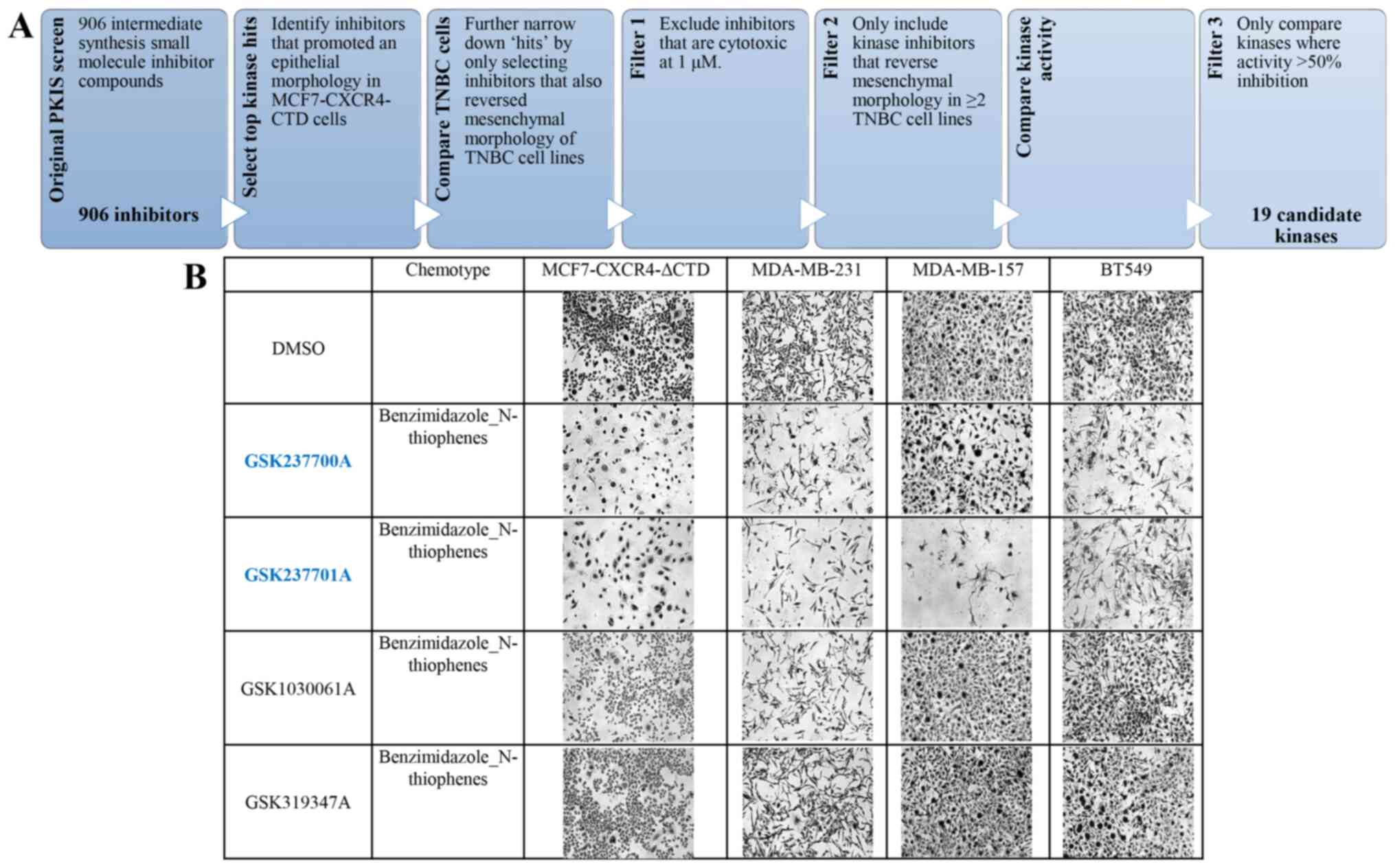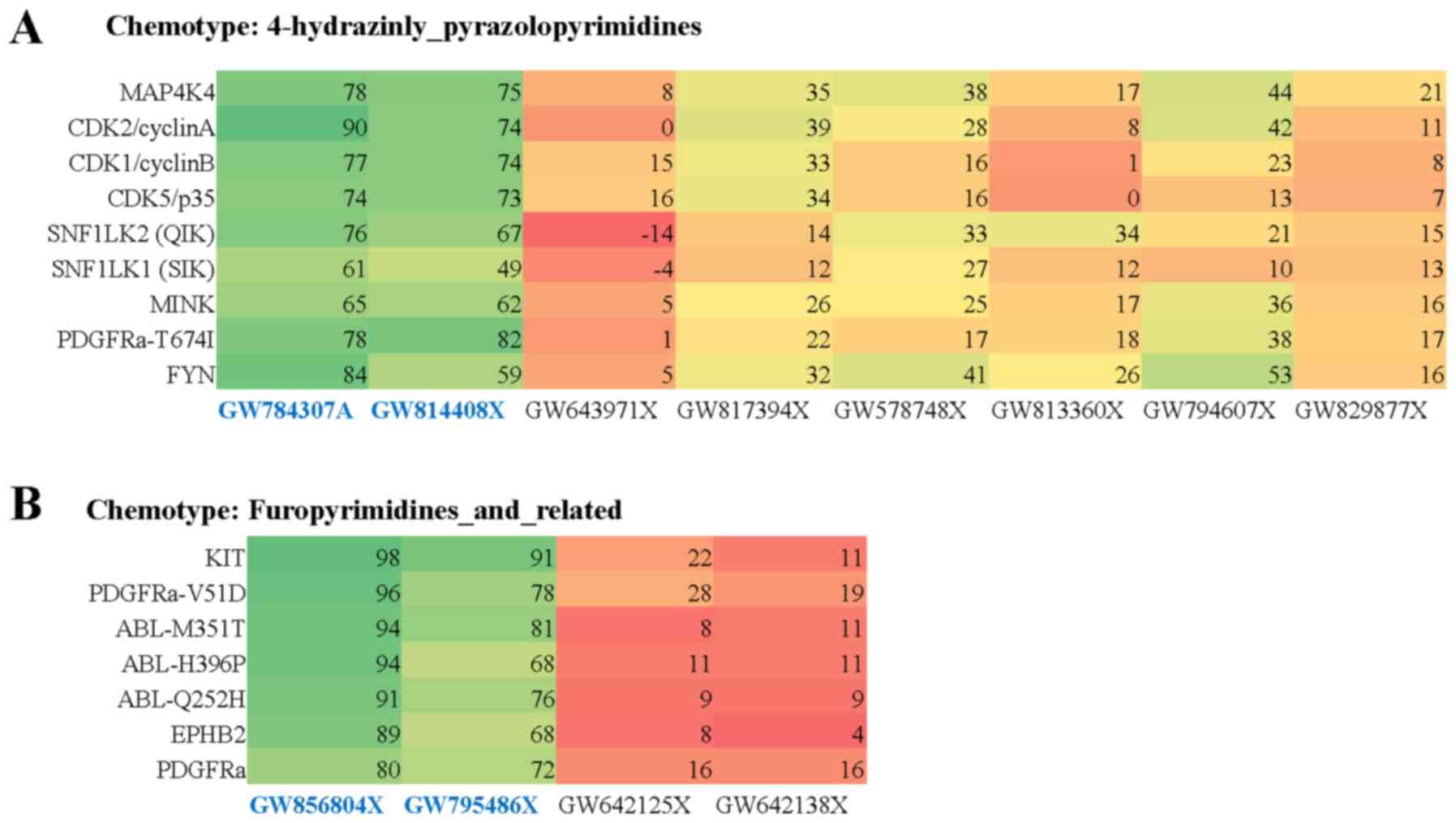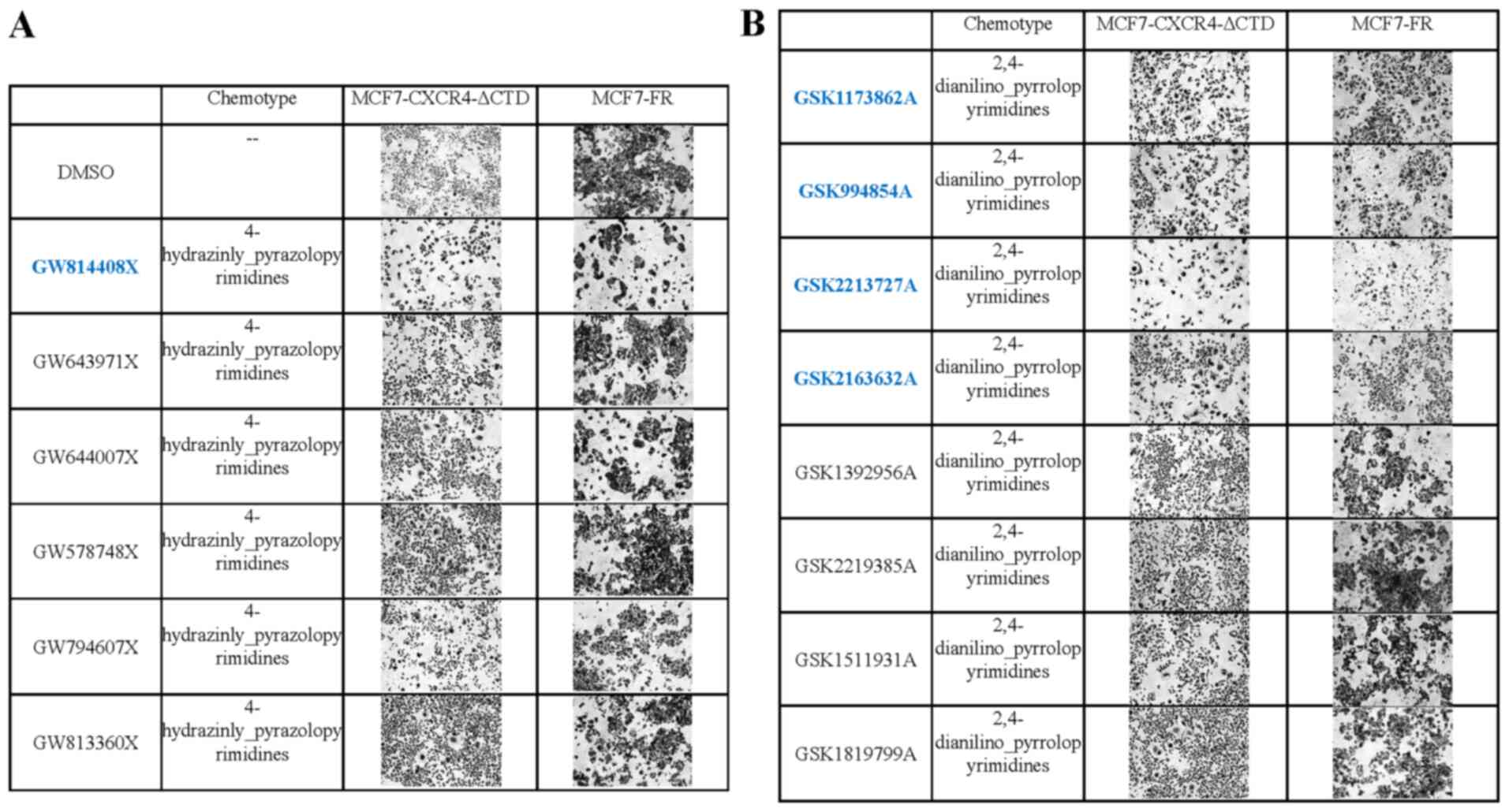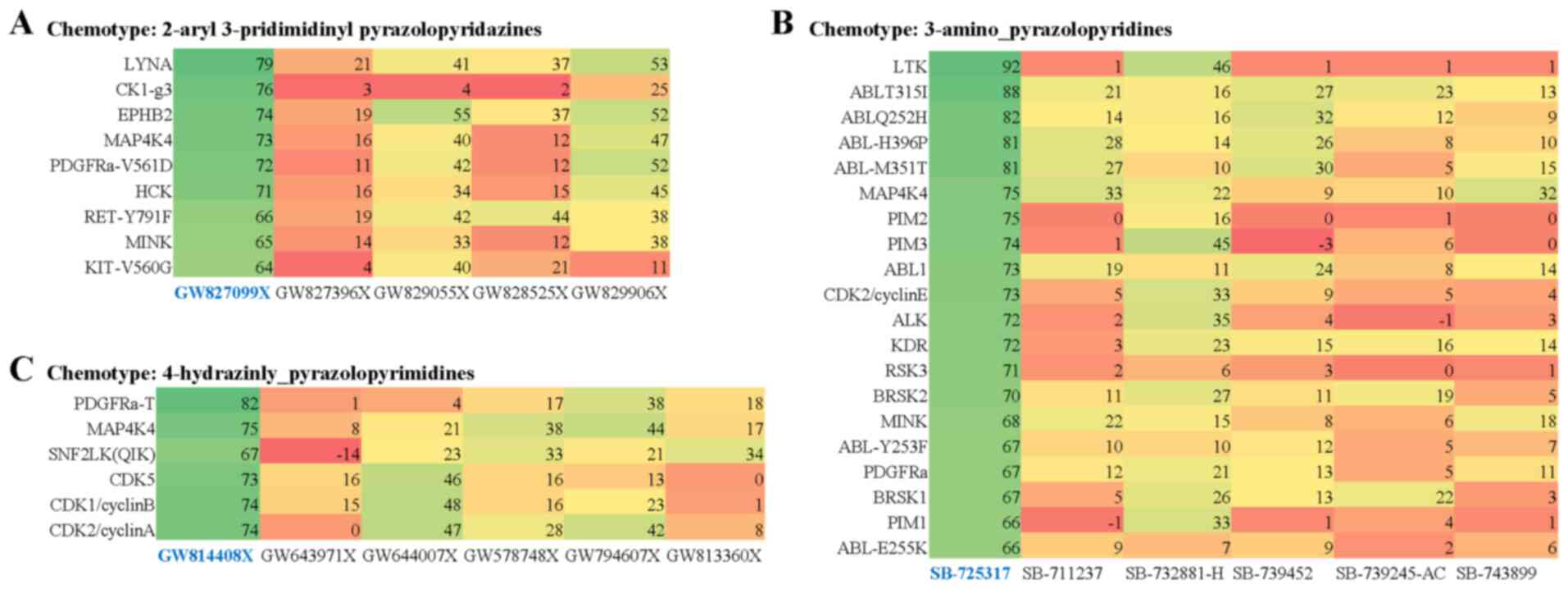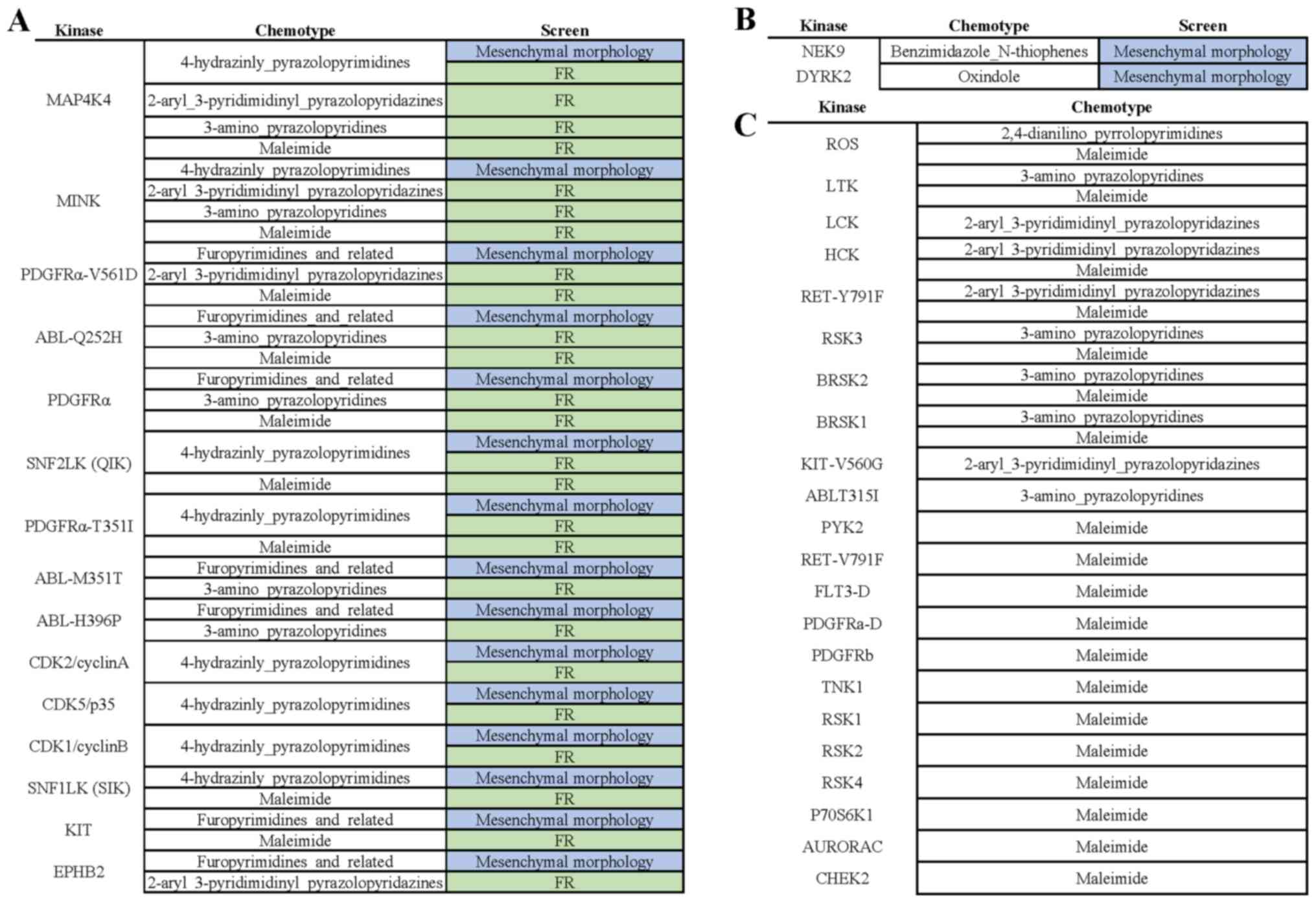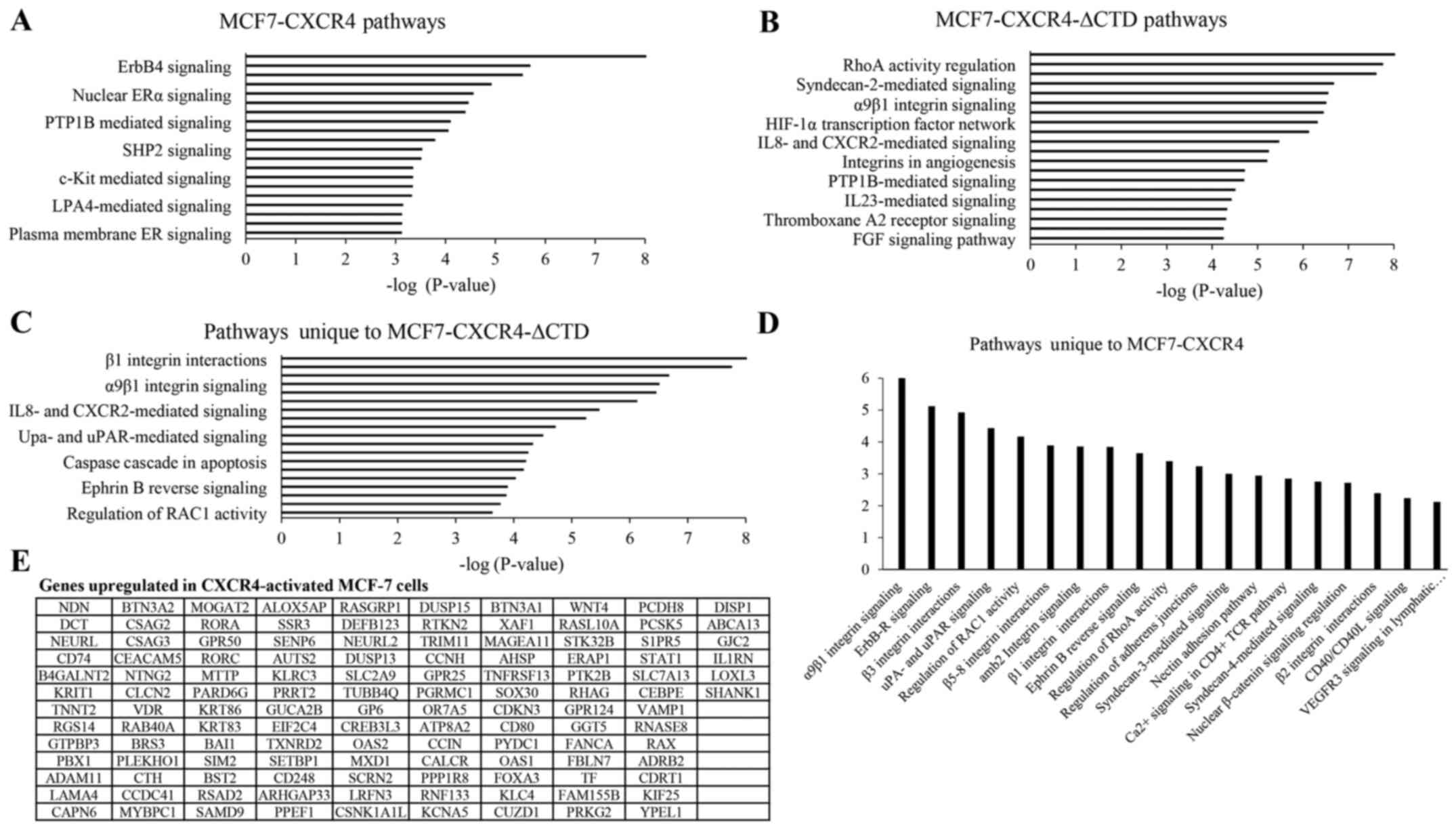|
1
|
Eggert US: The why and how of phenotypic
small-molecule screens. Nat Chem Biol. 9:206–209. 2013. View Article : Google Scholar : PubMed/NCBI
|
|
2
|
Elkins JM, Fedele V, Szklarz M, Abdul
Azeez KR, Salah E, Mikolajczyk J, Romanov S, Sepetov N, Huang XP,
Roth BL, et al: Comprehensive characterization of the published
kinase inhibitor set. Nat Biotechnol. 34:95–103. 2016. View Article : Google Scholar : PubMed/NCBI
|
|
3
|
Drewry DH, Wells CI, Andrews DM, Angell R,
Al-Ali H, Axtman AD, Capuzzi SJ, Elkins JM, Ettmayer P, Frederiksen
M, et al: Progress towards a public chemogenomic set for protein
kinases and a call for contributions. PLoS One. 12:e01815852017.
View Article : Google Scholar : PubMed/NCBI
|
|
4
|
Matossian MD, Elliott S, Hoang VT, Burks
HE, Phamduy TB, Chrisey DB, Zuercher WJ, Drewry DH, Wells C,
Collins-Burrow B and Burrow ME: Novel application of the published
kinase inhibitor set to identify therapeutic targets and pathways
in triple negative breast cancer subtypes. PLoS One.
12:e01778022017. View Article : Google Scholar : PubMed/NCBI
|
|
5
|
Rubin JB: Chemokine signaling in cancer:
One hump or two? Semin Cancer Biol. 19:116–122. 2009. View Article : Google Scholar : PubMed/NCBI
|
|
6
|
Balkwill FR: The chemokine system and
cancer. J Pathol. 226:148–157. 2012. View Article : Google Scholar : PubMed/NCBI
|
|
7
|
Chatterjee S, Behnam Azad B and Nimmagadda
S: The intricate role of CXCR4 in cancer. Adv Cancer Res.
124:31–82. 2014. View Article : Google Scholar : PubMed/NCBI
|
|
8
|
Bendall LJ, Baraz R, Juarez J, Shen W and
Bradstock KF: Defective p38 mitogen-activated protein kinase
signaling impairs chemotaxic but not proliferative responses to
stromal-derived factor-1alpha in acute lymphoblastic leukemia.
Cancer Res. 65:3290–3298. 2005. View Article : Google Scholar : PubMed/NCBI
|
|
9
|
Grande F, Giancotti G, Ioele G, Occhiuzzi
MA and Garofalo A: An update on small molecules targeting CXCR4 as
starting points for the development of anti-cancer therapeutics.
Eur J Med Chem. 139:519–530. 2017. View Article : Google Scholar : PubMed/NCBI
|
|
10
|
Walenkamp AME, Lapa C, Herrmann K and
Wester HJ: CXCR4 Ligands: The next big hit? J Nuc Med. 58 (Suppl
2):77S–82S. 2017. View Article : Google Scholar
|
|
11
|
Xu C, Zhao H, Chen H and Yao Q: CXCR4 in
breast cancer: Oncogenic role and therapeutic targeting. Drug Des
Devel Ther. 9:4953–4964. 2015.PubMed/NCBI
|
|
12
|
Eckert F, Schilbach K, Klumpp L, Bardoscia
L, Sezgin EC, Schwab M, Zips D and Huber SM: Potential role of
CXCR4 targeting in the context of radiotherapy and immunotherapy of
cancer. Front Immunol. 9:30182018. View Article : Google Scholar : PubMed/NCBI
|
|
13
|
Mukherjee D and Zhao J: The role of
chemokine receptor CXCR4 in breast cancer metastasis. Am J Cancer
Res. 3:46–57. 2013.PubMed/NCBI
|
|
14
|
Salvucci O, Bouchard A, Baccarelli A,
Deschênes J, Sauter G, Simon R, Bianchi R and Basik M: The role of
CXCR4 receptor expression in breast cancer: A large tissue
microarray study. Breast Cancer Res Treat. 97:275–283. 2006.
View Article : Google Scholar : PubMed/NCBI
|
|
15
|
Zhang Z, Ni C, Chen W, Wu P, Wang Z, Yin
J, Huang J and Qiu F: Expression of CXCR4 and breast cancer
prognosis: A systematic review and meta-analysis. BMC Cancer.
14:492014. View Article : Google Scholar : PubMed/NCBI
|
|
16
|
Okuyama Kishima M, de Oliveira CE,
Banin-Hirata BK, Losi-Guembarovski R, Brajão de Oliveira K,
Amarante MK and Watanabe MA: Immunohistochemical expression of
CXCR4 on breast cancer and its clinical significance. Anal Cell
Pathol (Amst). 2015:8910202015.PubMed/NCBI
|
|
17
|
Chu QD, Panu L, Holm NT, Li BD, Johnson LW
and Zhang S: High chemokine receptor CXCR4 level in triple negative
breast cancer specimens predicts poor clinical outcome. J Surg Res.
159:689–695. 2010. View Article : Google Scholar : PubMed/NCBI
|
|
18
|
Hassan S, Ferrario C, Saragovi U,
Quenneville L, Gaboury L, Baccarelli A, Salvucci O and Basik M: The
influence of tumor-host interactions in the stromal cell-derived
factor-1/CXCR4 ligand/receptor axis in determining metastatic risk
in breast cancer. Am J Pathol. 175:66–73. 2009. View Article : Google Scholar : PubMed/NCBI
|
|
19
|
Krohn A, Song YH, Muehlberg F, Dross L,
Bechmann C and Alt E: CXCR4 receptor positive spheroid forming
cells are responsible for tumor invasion in vitro. Cancer Lett.
280:65–71. 2009. View Article : Google Scholar : PubMed/NCBI
|
|
20
|
Graham NA and Graeber TG: Complexity of
metastasis-associated SDF-1 ligand signaling in breast cancer stem
cells. Proc Natl Acad Sci USA. 111:7503–7504. 2014. View Article : Google Scholar : PubMed/NCBI
|
|
21
|
Yi T, Zhai B, Yu Y, Kiyotsugu Y, Raschle
T, Etzkorn M, Seo HC, Nagiec M, Luna RE, Reinherz EL, et al:
Quantitative phosphoproteomic analysis reveals system-wide
signaling pathways downstream of SDF-1/CXCR4 in breast cancer stem
cells. Proc Natl Acad Sci USA. 111:E2182–E2190. 2014. View Article : Google Scholar : PubMed/NCBI
|
|
22
|
Mego M, Cholujova D, Minarik G, Sedlackova
T, Gronesova P, Karaba M, Benca J, Cingelova S, Cierna Z, Manasova
D, et al: CXCR4-SDF-1 interaction potentially mediates trafficking
of circulating tumor cells in primary breast cancer. BMC Cancer.
16:1272016. View Article : Google Scholar : PubMed/NCBI
|
|
23
|
Brabletz T, Kalluri R, Nieto MA and
Weinberg RA: EMT in cancer. Nat Rev Cancer. 18:128–134. 2018.
View Article : Google Scholar : PubMed/NCBI
|
|
24
|
Felipe Lima J, Nofech-Mozes S, Bayani J
and Bartlett JM: EMT in breast carcinoma-A review. J Clin Med.
5:652016. View Article : Google Scholar
|
|
25
|
Leggett SE, Sim JY, Rubins JE, Neronha ZJ,
Williams EK and Wong IY: Morphological single cell profiling of the
epithelial-mesenchymal transition. Integr Biol (Camb). 8:1133–1144.
2016. View Article : Google Scholar : PubMed/NCBI
|
|
26
|
Nelson CM, Khauv D, Bissell MJ and Radisky
DC: Change in cell shape is required for matrix
metalloproteinase-induced epithelial-mesenchymal transition of
mammary epithelial cells. J Cell Biochem. 105:25–33. 2008.
View Article : Google Scholar : PubMed/NCBI
|
|
27
|
Ueda Y, Neel NF, Schutyser E, Raman D and
Richmond A: Deletion of the COOH-terminal domain of CXC chemokine
receptor 4 leads to the down-regulation of cell-to-cell contact,
enhanced motility and proliferation in breast carcinoma cells.
Cancer Res. 66:5665–5675. 2006. View Article : Google Scholar : PubMed/NCBI
|
|
28
|
Sobolik T, Su YJ, Wells S, Ayers GD, Cook
RS and Richmond A: CXCR4 drives the metastatic phenotype in breast
cancer through induction of CXCR2 and activation of MEK and PI3K
pathways. Mol Biol Cell. 25:566–582. 2014. View Article : Google Scholar : PubMed/NCBI
|
|
29
|
Sun X, Cheng G, Hao M, Zheng J, Zhou X,
Zhang J, Taichman RS, Pienta KJ and Wang J: CXCL12/CXCR4/CXCR7
chemokine axis and cancer progression. Cancer Metastasis Rev.
29:709–722. 2010. View Article : Google Scholar : PubMed/NCBI
|
|
30
|
Rhodes LR, Short SP, Neel NF, Salvo VA,
Zhu Y, Elliott S, Wei Y, Yu D, Sun M, Muir SE, et al: Cytokine
receptor CXCR4 mediates estrogen-independent tumorigenesis,
metastasis, and resistance to endocrine therapy in human breast
cancer. Cancer Res. 71:603–613. 2010. View Article : Google Scholar : PubMed/NCBI
|
|
31
|
Liang S, Peng X, Li X, Yang P, Xie L, Li
Y, Du C and Zhang F: Silencing of CXCR4 sensitizes triple-negative
breast cancer cells to cisplatin. Oncotarget. 6:1020–1030. 2015.
View Article : Google Scholar : PubMed/NCBI
|
|
32
|
Wang Y, Yan L, Zhang L, Xu H, Chen T, Li
Y, Wang H, Chen S, Wang W, Chen C and Yang Q: NT21MP negatively
regulates paclitaxel-resistant cells by targeting miR-155-3p and
miR-155-5p via the CXCR4 pathway in breast cancer. Int J Oncol.
53:1043–1054. 2018.PubMed/NCBI
|
|
33
|
Liu S, Xie SM, Yang-Kolodji G and Tripathy
D: Targeting the tumor microenviroment by CXCR4 inhibition to
abrogate trastuzumab resistance in HER2-positive breast cancer.
Cancer Res. 79 (Suppl 4):P5-03-04. 2019.
|
|
34
|
Rhodes LV, Antoon JW, Muir SE, Elliott S,
Beckman BS and Burrow ME: Effects of human mesenchymal stem cells
on ER-positive human breast carcinoma cells mediated through
ER-SDF-1/CXCR4 crosstalk. Mol Cancer. 9:2952010. View Article : Google Scholar : PubMed/NCBI
|
|
35
|
Rhodes LV, Bratton MR, Zhu Y, Tilghman SL,
Muir SE, Salvo VA, Tate CR, Elliott S, Nephew KP, Collins-Burow BM
and Burow ME: Effects of SDF-1-CXCR4 signaling on microRNA
expression and tumorigenesis in estrogen receptor-alpha
(ER-α)-positive breast cancer cells. Exp Cell Res. 317:2573–2581.
2011. View Article : Google Scholar : PubMed/NCBI
|
|
36
|
Sauvé K, Lepage J, Sanchez M, Heveker N
and Tremblay A: Positive feedback activation of estrogen receptors
by the CXCL12-CXCR4 pathway. Cancer Res. 69:5793–5800. 2009.
View Article : Google Scholar : PubMed/NCBI
|
|
37
|
Dubrovska A, Hartung A, Bouchez LC, Walker
JR, Reddy VA, Cho CY and Schultz PG: CXCR4 activation maintains a
stem cell population in tamoxifen-resistant breast cancer cells
through AhR signalling. British J Cancer. 107:43–52. 2012.
View Article : Google Scholar
|
|
38
|
Fan M, Yan PS, Hartman-Frey C, Chen L,
Paik H, Oyer SL, Salisbury JD, Cheng AS, Li L, Abbosh PH, et al:
Diverse gene expression and DNA methylation profiles correlate with
differential adaptation of breast cancer cells to the antiestrogens
tamoxifen and fulvestrant. Cancer Res. 66:11954–11966. 2006.
View Article : Google Scholar : PubMed/NCBI
|
|
39
|
Ptasznik A, Urbanowska E, Chinta S, Costa
MA, Katz BA, Stanislaus MA, Demir G, Linnekin D, Pan ZK and Gewirtz
AM: Crosstalk between BCR/ABL oncoprotein and CXCR4 signaling
through a Src family kinase in human leukemia cells. J Exp Med.
196:667–678. 2002. View Article : Google Scholar : PubMed/NCBI
|
|
40
|
Dillmann F, Veldwijk MR, Laufs S,
Sperandio M, Calandra G, Wenz F, Zeller J and Fruehauf S:
Plerixafor inhibits chemotaxis toward SDF-1 and CXCR4-mediated
stroma contact in a dose-dependent manner resulting in increased
susceptibility of BCR-ABL+ cell to Imatinib and Nilotinib. Leuk
Lymphoma. 50:1676–1686. 2009. View Article : Google Scholar : PubMed/NCBI
|
|
41
|
Smith-Pearson PS, Greuber EK, Yogalingam G
and Pendergast AM: Abl kinases are required for invadopodia
formation and chemokine-induced invasion. J Biol Chem.
285:40201–40211. 2010. View Article : Google Scholar : PubMed/NCBI
|
|
42
|
Kaenel P, Mosimann M and Andres AC: The
multifaceted roles of Eph/ephrin signaling in breast cancer. Cell
Adh Migr. 6:138–147. 2012. View Article : Google Scholar : PubMed/NCBI
|
|
43
|
Haldimann M, Custer D, Munarini N,
Stirnimann C, Zürcher G, Rohrbach V, Djonov V, Ziemiecki A and
Andres AC: Deregulated ephrin-B2 expression in the mammary gland
interferes with the development of both the glandular epithelium
and vasculature and promotes metastasis formation. Int J Oncol.
35:525–536. 2009.PubMed/NCBI
|
|
44
|
Lamb CA, Helguero LA, Fabris V, Lucas C,
Molinolo AA and Lanari C: Differential effects of raloxifene,
tamoxifen and fulvestrant on a murine mammary carcinoma. Breast
Cancer Res Treat. 79:25–35. 2003. View Article : Google Scholar : PubMed/NCBI
|
|
45
|
Giuliano M, Schiff R, Osborne CK and
Trivedi MV: Biological mechanisms and clinical implications of
endocrine resistance in breast cancer. Breast. 20 (Suppl
3):S42–S49. 2011. View Article : Google Scholar : PubMed/NCBI
|















